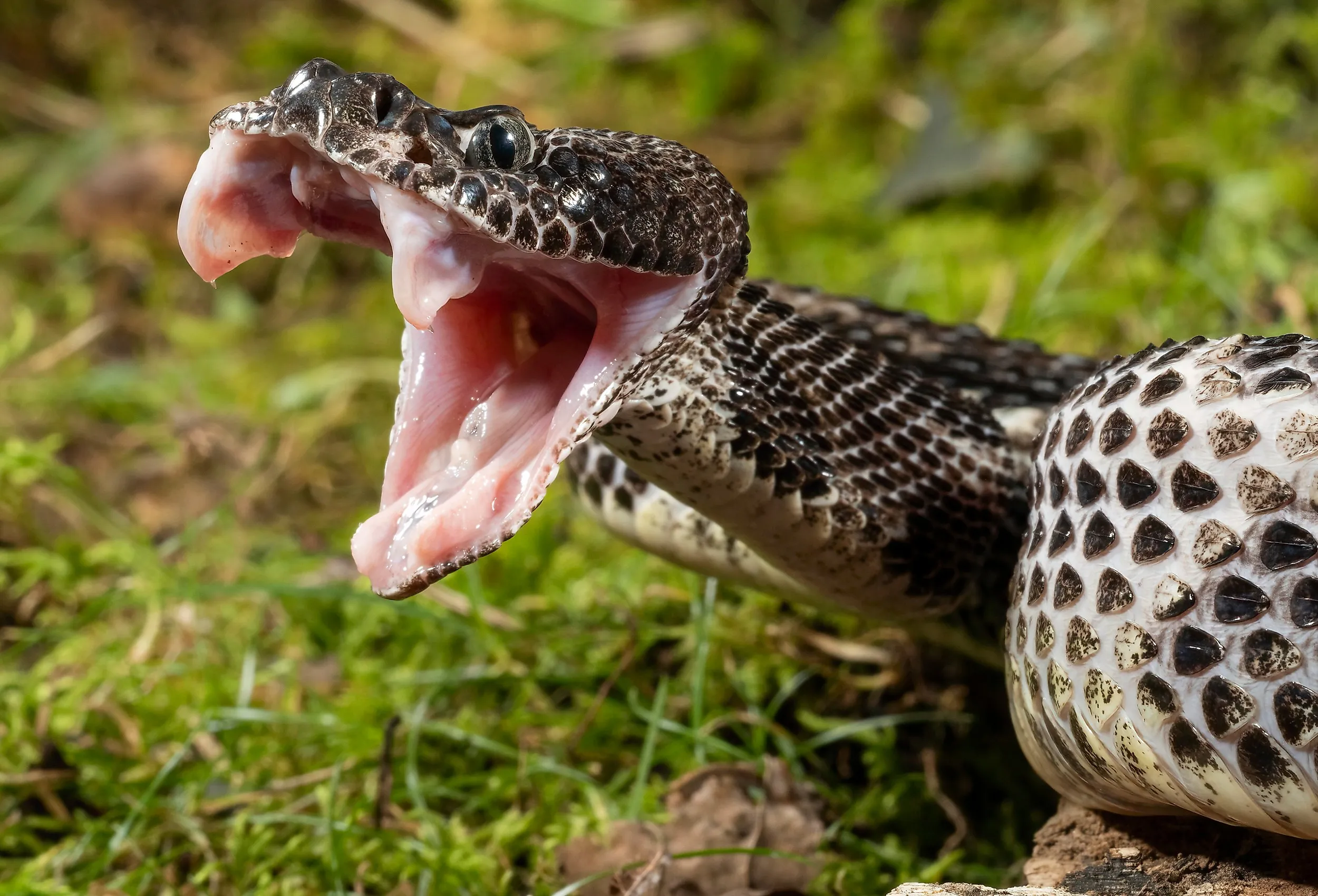
The Venomous Snakes of Tennessee
Whether you are heading to Tennessee for a weekend getaway, a family vacation, or an outdoor adventure, it is important to know what to expect ahead of time. There is lots to explore in the Volunteer State, which boasts many incredible tourist attractions, including the bright lights of Nashville, the natural splendor of the Appalachian Mountains, and the rock n’ roll charm of Memphis, but it’s also home to some potentially dangerous wildlife. There are over 30 species of snakes in Tennessee, five of which are venomous. While most interactions with these snakes pass peacefully, it’s good to know how to identify them and learn their habits so you can stay safe while discovering everything Tennessee has to offer.
Southern Copperhead
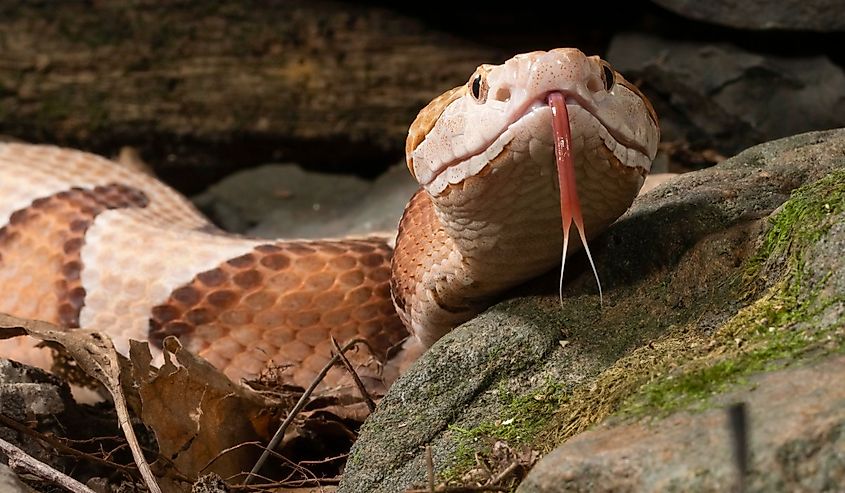
The Southern Copperhead, or Agkistrodon contortrix contortrix, gets its name from its distinctive rust-colored markings on the top of its large, triangular-shaped head. This subspecies can grow up to 4ft long and is typically larger than others in the Copperhead family. You can easily identify them from the dark brown hourglass-shaped bands along their lighter, tan-colored bodies. Young Southern Copperheads are greyer in color and the tip of their tail is bright yellow. This marker helps them attract food — the prey thinks the yellow tip is a caterpillar or worm, comes over to investigate, and becomes dinner. This tactic is known as caudal luring.
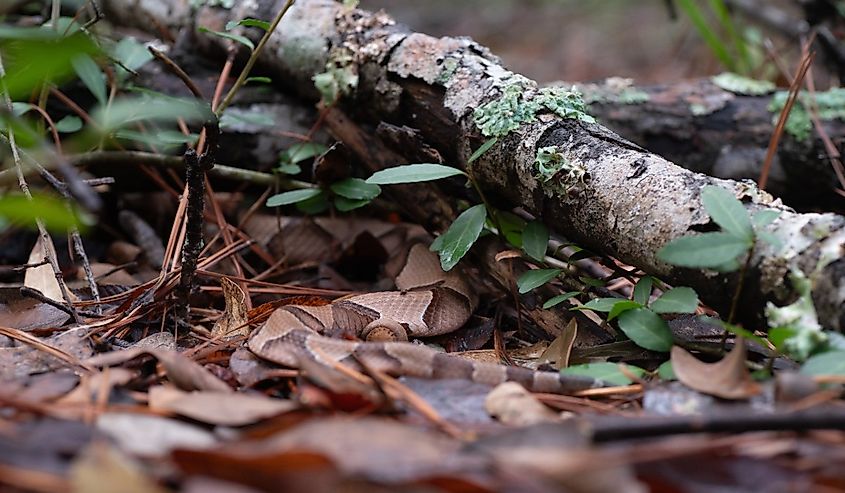
Despite the name, Southern Copperheads are mostly found in western Tennessee. They tend to avoid open areas, preferring the shelter of the forest, and are often spotted on rocky, wooded hillsides where they can take over under logs, rocks, or leaves. They may be shy, but these snakes can still find their way into urban areas and have been seen near wetlands and streams. Their diet consists of mice, small birds, lizards, snakes, amphibians, and insects.
Be especially alert for Southern Copperheads during spring and fall when they are most active. At these times of year, they are mating and it’s not unusual for the males to get involved in heated combat, raising the front of their bodies to strike at each other.
Northern Copperhead
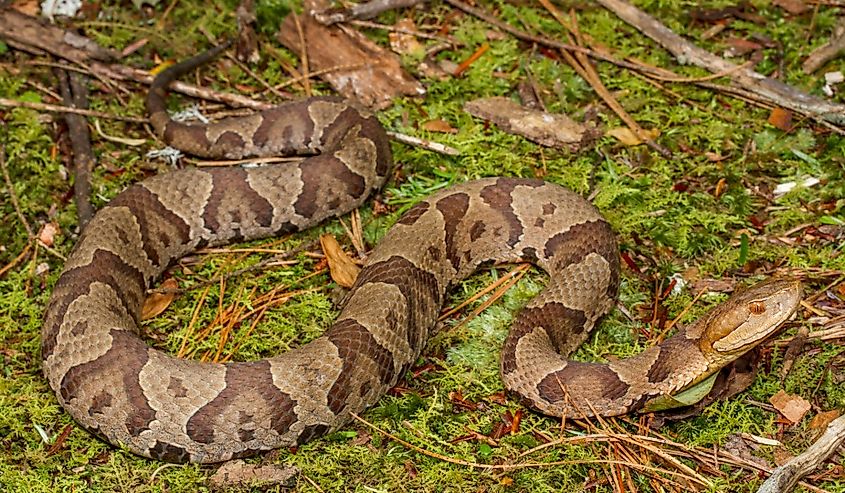
While the Southern Copperhead is found in western Tennessee, its Northern cousin lives across the state. Also known as Agkistrodon contortrix mokasen, this pit viper has similar markings, coloring (with slightly darker, chestnut-brown crossbands), diet, and habits as the Southern subspecies. It’s also a large snake, reaching up to 4ft long.
When disturbed, alarmed, or threatened, copperheads will coil up tightly, raise their heads, and vibrate their tails. If you come across a copperhead and notice this kind of behavior, stay calm. Move slowly away from the snake, without making any sudden movements or noises. Bear in mind that copperhead venom is not terribly potent, so deaths from bites are very rare, but it's still important to seek medical attention if bitten.
Western Cottonmouth

The Agkistrodon piscivorus leucostoma, or western cottonmouth, also goes by another name — the water moccasin. These venomous vipers are found in west Tennessee, on the northern Highland Rim, and have varied coloring. Some are dark brown, others more of an olive hue. They do have dark bands around their body, but these aren’t always easy to see as they blend in with the rest of the body. Western cottonmouths have dark heads with a white upper lip. Young snakes are lighter in color and have a yellow-green tip on their tail.
An average of 3ft long, this subspecies likes to hang out where it is damp, like swamps, wetlands, drainage ditches, rivers, and lakes. You might encounter them on the shore, sunning on the bank, or even swimming in the water. When they are in the water, they swim with their heads above the surface, unlike other aquatic snake species. They eat fish, frogs, salamanders, lizards, birds, rodents, and other snakes.
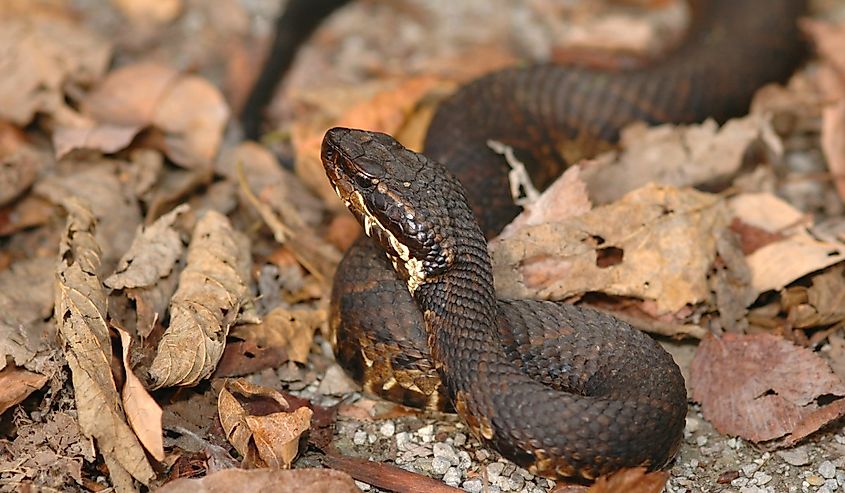
Cottonmouths usually mate in spring when they perform a swaying slither to attract females. If you have heard of cottonmouths or know them as water moccasins, you are probably familiar with their scary reputation. This isn’t entirely accurate. A cottonmouth will assume a defensive posture when threatened, opening its mouth wide to show its puffy white gums (this is where it gets its name), but the snake is just posturing. Cottonmouths will only bite if they have to defend themselves; they are not aggressive by nature. It’s also important to note that an escaping Cottonmouth may suddenly swerve towards you. This isn’t to challenge you; it’s merely a defense mechanism as they try to flee. Stay calm, and continue to move away slowly so the snake sees you are not a threat.
Timber Rattlesnake
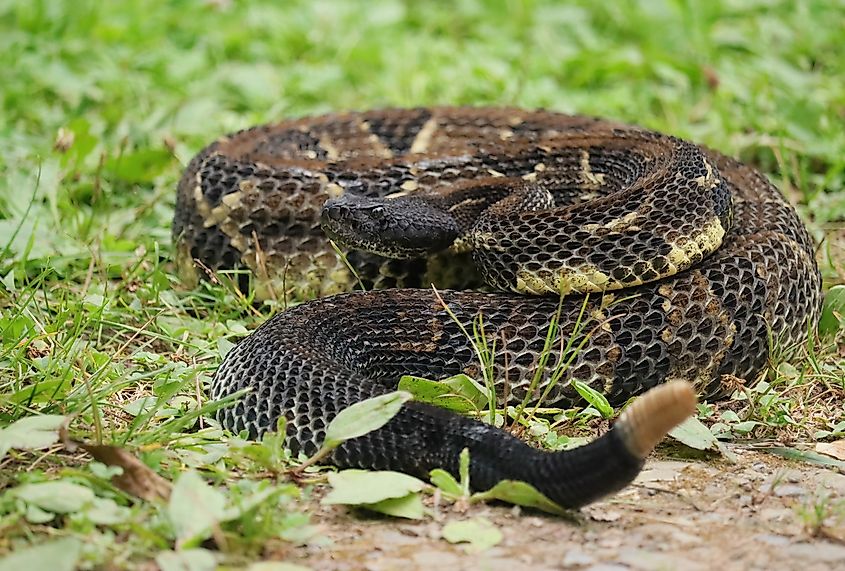
The timber rattlesnake, Crotalus horridus, is the largest of all of Tennessee’s venomous snakes, growing up to 6ft long. They are found all over Tennessee and can be tough to identify as there is a lot of variation in coloring. Typically yellowish-brown or grey, they can also be tan, brown, pink, or black. They have chevron-shaped bands along their body and a rust-colored stripe down their back. One way to tell for sure it’s a rattlesnake is the rattle at the tip of their tail, their triangular head, and vertical pupils.
Timber rattlesnakes prefer forested habitats and mountains with rocky hillsides that face south to catch the sun. They can be found on bluffs or cliffs, as well as swamps, thickets, wooded streams, rocks, and logs. They feed on small rodents, birds, lizards, and small mammals like squirrels. Timber rattlesnakes mate and birth in late summer and early fall but their populations are falling in Tennessee due to loss of habitat, road deaths, and human interaction.
Western Pygmy Rattlesnake
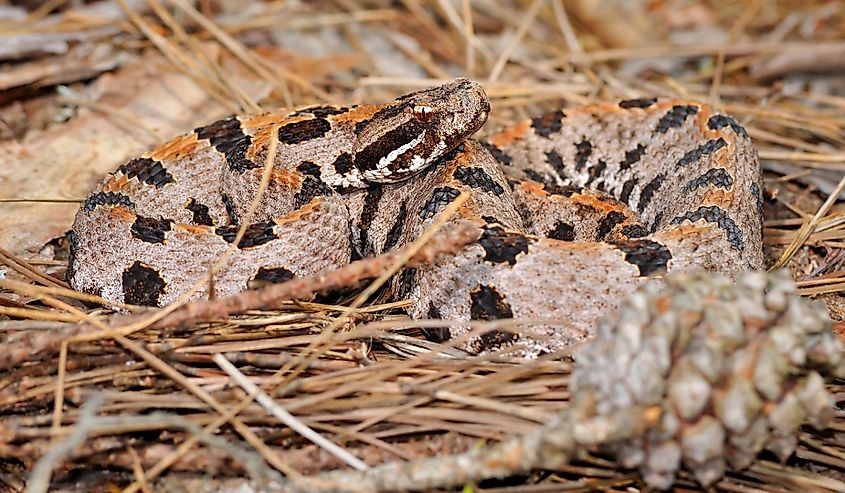
Sistrurus miliarius streckeri, the western pygmy rattlesnake, is the smallest venomous snake in Tennessee, reaching only 2ft in length. Also known as the ground rattler, this snake is tan, grey, or reddish with a red or rust-colored stripe down its back and black or brown splotches along its spine. The top of its head often has two stripes that run down towards its neck.
Western pygmy rattlesnakes aren’t just small in terms of their length; they also have a smaller rattle that produces a low buzzing noise that’s easy to miss. These rattlers are found along the western Highland Rim of Tennessee, from Stewart County all the way down to the state’s southern border. Like their larger cousins, the western pygmy rattlesnake likes to be close to water and is a strong swimmer. You will find them in floodplains, marshes, wetlands, woods, and glades. They eat rodents, frogs, lizards, amphibians, and small snakes.
The western pygmy rattlesnake is considered rare to very rare in Tennessee and is listed as Threatened by the Tennessee Wildlife Resources Agency.
Staying Safe Around Snakes
If you are hiking, picnicking at the lake, or even just exploring Tennessee’s small rural towns, there is a chance you will run into one of the state’s venomous snakes. If that happens, don’t be alarmed. They don’t want a confrontation any more than you do! The best thing you can do is simply leave the snake alone. Keep pets leashed, don’t let kids wander from the path, and watch where you are putting your feet, especially in rocky areas and other terrain that provides good cover for snakes, such as leafy paths. It is illegal to kill a snake in Tennessee unless it poses an immediate danger to your health. On the rare chance that you are bitten, seek medical attention as soon as possible but don’t panic — the vast majority of snake bites in Tennessee are non-fatal.











